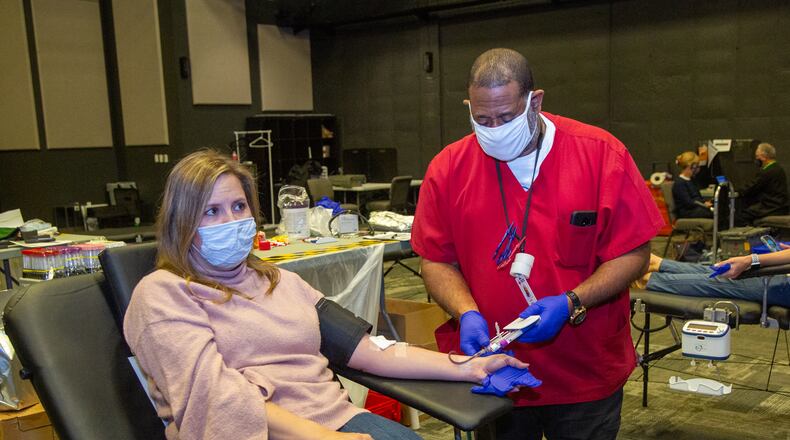It was 2007, I was 25 and had no interest in being a blood donor – too squeamish, I claimed – but I thought it was a great thing for other people to do. Arthur Stoltz was 85 that year and the recipient of the Lifetime Achievement Award from the American Red Cross for donating nearly 15 gallons of blood. I sat next to him at the award ceremony because I was writing a story about his accomplishment for The Atlanta Journal-Constitution. Mr. Stoltz told me about how he became a donor 51 years prior. His son was born with jaundice and needed a complete blood change. Mr. Stoltz eagerly rolled up his sleeve to donate blood for his boy, and he chose to keep going once his son’s transfusions were complete. He also volunteered for the Red Cross for 40 years.
Mr. Stoltz and I were accompanied at our table by a mother and her young son who had a condition that required blood transfusions every three to four weeks. I was in awe of Mr. Stoltz’ selflessness and by the challenges for the mother and her child with medical tubes streaming from his shirt. I was moved and oblivious to how my life would ever resemble theirs.
I became a mother in the summer of 2011. My son Max, a beautiful boy with dark curls and full features, was born with Costello syndrome, a rare disease that effects about 1 in 30 million. I wrote about our journey with Max in 2015 for The Atlanta Journal-Constitution. Max’s diagnosis came with an assortment of health concerns, including feeding issues. He was fed by a nasal-gastric tube until he was three months old, then a more permanent gastronomy tube was placed in his stomach. Despite the health issues, Max was a happy, outgoing boy who loved people, music, and walks in his stroller. He was a doting big brother and enthusiastic about most everything.
Credit: Picasa
Credit: Picasa
Max needed mitral valve repair surgery in October 2017. Though all appeared to be fine after the operation, a stroke was discovered about 24 hours into his recovery and, after trying all we could to save him, including a plasma transfusion, he passed days later. His absence is both excruciating and numbing. I am constantly amazed that my mind and body still function, as there isn’t a part of me, not a finger, nor a hair on my head, that does not ache with grief.
Three years have passed and one of Max’s little brothers is now in kindergarten. When his school promoted a blood drive in August, my mind flashed back to that night years ago with Mr. Stoltz and the woman with her medically fragile son. That is when the irony of their lives and mine struck. Her boy with the tubes beneath his shirt, my Max with his. Without much thought, I hit register and signed up to donate blood for the first time in my life.
I was nervous when I arrived to donate that fall morning, afraid I would get queasy, but also determined, with Max’s face ever-present in my thoughts. As I sat there waiting for my turn, someone caught my eye. Monica Mangram, Max’s occupational therapist had walked through the door. Over the years, I had shared Max with a handful of doctors, nurses, teachers and therapists, and they loved him dearly. When I lost Max, I clung to those people, my “Max people” as I call them, as they are a comfort and a reminder of precious days. It felt serendipitous, purposeful that Mangram showed up at the blood drive. We donated side by side, laughing and talking, and then, without the slightest cringe or gag on my part, it was over. It was quick, painless, and I felt like a complete fool. It was the simplest of tasks for me, yet life-giving for another. I felt guilty, even selfish for avoiding the experience for so long.
Throughout Max’s six years, he and I logged many visits at the Aflac Cancer and Blood Disorders Center at Egleston Hospital for his quarterly cancer screenings that are protocol with Costello syndrome. We frequently saw cancer-stricken children who regularly received transfusions. In the past two years, I have had two friends, including another of my “Max people,” fight for their lives after tremendous blood loss during childbirth, and my husband’s boss is currently fighting a blood cancer that has required the transfusion of 16 units of blood. Our bodies have 10 units.
The need for blood is constant and donations are scarce. According to the American Red Cross, an estimated 38% of the population is eligible to donate and only about 8% of that number actually donates. Seventy percent of first-time blood donors do not return to give again.
I am now a regular donor. I will give my fourth donation this month. I have the American Red Cross app on my phone, I register for drives as soon as I leave another, and I receive occasional notifications about where my blood is being delivered.
I have thought many times about how much blood I could have donated if I had started when I was 16, the minimum age to donate with parental consent. Twenty-two years, six donations a year – I could have given over 16 gallons by now, surpassing Mr. Stoltz’ record. I am determined I still will. I will continue to donate blood for the parents whose children are fighting for their lives, for friends and family, for strangers, and in memory of Mr. Stoltz, who passed in 2019. Most of all, just as Mr. Stoltz gave for his son, I will give in honor of mine.
HOW TO DONATE
If you would like to become a blood donor, there are multiple sites to visit to find blood drives near you, including:
About the Author
Keep Reading
The Latest
Featured


